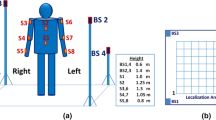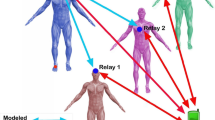Abstract
The main purpose of this work is to measure and analyze the propagation loss of the Wireless Body Area Network (WBAN) in frequency and time domain at two frequency bands, namely 2.4 GHz band with 80 MHz bandwidth and 3.35 GHz band with 500 MHz bandwidth. Four different scenarios (front to front, front to back, front to off-body node and back to off-body node) using many antenna´s locations on the body are used to investigate the channel response (path loss) of WBAN. It is found that the front to front channels and the front to off-body node channels have a low fading. The front to back channels and the back to off-body node channels have a high fading that can be approximated by the Distorted Rayleigh fading. Thus the WBAN range for the front to off-body node scenario is more than the range of the back to off-body node scenario.






























Similar content being viewed by others
References
Oppermann, I., Hamalainen, M., & Iinatti, J. (2004). UWB theory and applications. West Sussex: Wiley.
IEEE Standard for Local and Metropolitan Area Networks. (2012). IEEE 802.15.6-2012, part 15.6: Wireless body area networks.
Khan, M. M., Abbasi, Q. H., Liaqat, S., & Alomainy, A. (2012). Comparison of two measurement techniques for UWB on-body radio channel characterization. Progress in Electromagnetics Research M,27, 179–189.
Garcia-Serna, R.-G., Garcia-Pardo, C., & Molina-Garcia-Pardo, J. (2015). Effect of the receiver attachment position on ultrawideband off-body channels. IEEE Antennas and Wireless Propagation Letters,14, 1101–1104.
Taparugssanagorn, A., Tesi, R., Pomalaza-Ráez, C., Hamalainen, M., & Iinatti, J. (2009). Effect of body motion and the type of antenna on the measured UWB channel characteristics in medical applications of wireless body area networks. In Proceedings of the IEEE international conference on ultra-wideband (ICUWB) (pp. 332–336).
Thotatewa, K. M. S., Redoutè, J.-M., & Yuce, M. R. (2015). Propagation, power absorption and analysis of UWB wireless capsule endoscopy devices operating in the human body. IEEE Transactions on Microwave Theory and Techniques,63(11), 3823–3833.
Mohammadi, Z., Saadane, R., & Aboutajdine, D. (2014). New high-rate UWB scheme for WBAN-based healthcare systems. Progress in Electromagnetics Research B,60, 125–139.
Abbasi, Q. H., Khan, M. H., Liaqat, S., Kamran, M., Alomainy, A., & Hao, Y. (2013). Experimental investigation of ultra wideband diversity techniques for on-body radio communications. Progress in Electromagnetics Research C,34, 165–181.
Gao, A.-M., Xu, Q.-H., Peng, H.-L., Jiang, W., & Jiang, Y. (2012). Performance evaluation of UWB on-body communication under WiMAX off-body EMI existence. Progress in Electromagnetics Research,132, 479–498.
Alomainy, A., Hao, Y., Hu, X., Parini, C. G., & Hall, P. S. (2006). UWB on-body radio propagation and system modelling for wireless body-centric networks. IEE Proceedings-Communications,153(1), 107–114.
Fort, A., Desset, C., de Doncker, P., Wambacq, P., & van Biesen, L. (2006). An ultra-wideband body area propagation channel—From statistics to implementation. IEEE Transactions on Microwave Theory and Techniques,54(4), 1820–1826.
Molisch, A. F., Cassioli, D., Chong, C.-C., Emami, S., Fort, A., Kannan, B., et al. (2006). A comprehensive standardized model for ultrawideband propagation channels. IEEE Transactions on Antennas and Propagation,54(11), 3151–3166.
Di Bari, R., Abbasi, Q. H., Alomainy, A., & Hao, Y. (2013). An advanced UWB channel model for body-centric wireless networks. Progress in Electromagnetics Research,136, 79–99.
Alomainy, A., Hao, Y., Parini, C. G., & Hall, P. S. (2005). Comparison between two different antennas for UWB on-body propagation measurements. IEEE Antennas Wireless Propagation Letters,4, 31–34.
Khaleghi, A., & Balasingham, I. (2009). Non-line-of-sight on-body ultra-wideband (1–6 GHz) channel characterisation using different antenna polarisations. IET Microwaves, Antennas and Propagation,3(7), 1019–1027.
Kumpuniemi, T., Tuovinen, T., Hamalainen, M., Yekeh Yazdandoost, K., Vuohtoniemi, R., & Iinatti, J. (2013). Measurement-based on-body path loss modelling for UWB WBAN communications. In Proceedings of the 7th international symposium on medical information and communication technology (ISMICT) (pp. 233–237).
Kumpuniemi, T., Hamalainen, M., Tuovinen, T., Yekeh Yazdandoost, K., & Iinatti, J. (2013). Generic small scale channel model for on-body UWB WBAN communications. In Proceedings of the 2nd ultra wideband for body area networking workshop (UWBAN), Co-located with the 8th international conference on body area networks (BodyNets) (pp. 570–574).
Vorobyov, A. V., & Yarovoy, A. G. (2012). Human body impact on UWB antenna radiation. Progress in Electromagnetics Research M,22, 259–269.
Wang, Q., Tayamachi, T., Kimura, I., & Wang, J. (2009). An on-body channel model for UWB body area communications for various postures. IEEE Transactions on Antennas Propagation,57(4), 991–998.
Klemm, M., & Troester, G. (2006). EM energy absorption in the human body tissues due to UWBantennas. Progress in Electromagnetics Research,62, 261–280.
Smith, D. B., Miniutti, D., Lamahewa, T. A., & Hanlen, L. W. (2013). Propagation models for body area networks: A survey and new outlook. IEEE Antennas and Propagation Magazine,55(5), 97–117.
Chen, M., Gonzalez, S., Vasilakos, A., Cao, H., & Leung, V. C. M. (2011). Body area networks: A survey. Mobile Networks Applications,16, 171–193.
Cotton, S. L. (2014). A statistical model for shadowed body-centric communications channels: Theory and validation. IEEE Transactions on Antennas and Propagation,62(3), 1416–1424.
Negra, R., Jemili, I., Zemmari, A., & Mosbah, M. (2018). WBAN path loss based approach for human activity recognition with machine learning techniques. In 2018 14th international wireless communications and mobile computing conference (IWCMC) (pp. 470–475).
Goswami, D., Sarma, K. C., & Mahanta, A. (2016). Path loss variation of on-body UWB channel in the frequency bands of IEEE 802.15.6 standard. Healthcare Technology Letters,3(2), 129–135.
Chavez-Santiago, R., Garcia-Pardo, C., Fornes-Leal, A., et al. (2015). Experimental path loss models for in-body communications within 2.36–2.5 GHz. IEEE Journal of Biomedical and Health Informatics,19(3), 930–937.
Garcia-Serna, R.-G., Garcia-Pardo, C., & Molina-Garcia-Pardo, J.-M. (2015). Effect of the receiver attachment position on ultrawideband off-body channels. IEEE Antennas Wireless Propagation Letters,14, 1101–1104.
Thielens, R. A., Benarrouch, R., Wielandt, S., Anderson, M. G., Moin, A., Cathelin, A., et al. (2018). A comparative study of on-body radio-frequency links in the 420 MHz–2.4 GHz. Sensors Journal,18, 4165. https://doi.org/10.3390/s18124165.
Author information
Authors and Affiliations
Corresponding author
Additional information
Publisher's Note
Springer Nature remains neutral with regard to jurisdictional claims in published maps and institutional affiliations.
Appendix: Distorted Rayleigh Distribution
Appendix: Distorted Rayleigh Distribution
In probability theory, the Rayleigh distribution is a continuous probability distribution for positive-value random variable x representing the voltage of the received signal. It could also represented in dB giving a rise to positive and negative dB values. The probability density function f(x) is given as:
Distorted Rayleigh distribution is a weighted sum of Rayleigh distribution and one or more truncated Gaussian (Normal) Distributions. Distortion can happen in the leading edge, trailing edge or near to the peak of the Rayleigh distribution.
Suppose that X = N (μ, σ2) has a normal distribution and lies within the interval − ∞ ≤ a < b ≤ ∞. Then X conditional on a < X < b has a truncated normal distribution.
Its probability density function f (x), for a ≤ x ≤ b is given by:
where
In our case a = 0, b = ∞ and \(\Phi \left( {\frac{b - \mu }{\sigma }} \right)\) = 0.
The probability density function f(x) DR of the distorted Rayleigh distribution is given as:
where WG,n is the weight of the Gaussian component n, WR is the weight of the Rayleigh component
Figure 31 shows the PDF of the Rayleigh distribution where the relative power from the mean value is given in dB for σ = 1.0 and 1.5
Figure 32 shows the PDF of the First Type of distorted Rayleigh distribution (sum of 50% of Rayleigh distribution and 50% of a Gaussian one with μ = 3.6 and sigma of 0.8). A peak at 0.1 dB can be noticed and another peak with lower PDF at 11.1 dB can be seen
Figure 33 depicts the PDF of the Second Type of the distorted Rayleigh distribution (sum of 95% of Rayleigh distribution and 5% of a Gaussian one with μ = 0.45 and sigma of 0.1). Two peaks can be seen. The first one is at 0 dB (due to the Rayleigh component) and the second one is at − 6.3 dB (due to the Gaussian component affected by the Rayleigh component)
Figure 34 depicts the PDF of the third type of the distorted Rayleigh distribution (sum of 99% of Rayleigh distribution and 1% of a Gaussian one with μ = 0.05 and sigma of 0.015). Two peaks can be seen. The first one is at 0 dB and the second one is at − 25.9 dB. The first peak is due to the Rayleigh component. The second peak is due to the Gaussian component affected by the Rayleigh component)
Figures 32, 33 and 34 show that the distorted Rayleigh distribution has many shapes depending on the weight of and parameters of its components. This means that it can represents the Hypo-Rayleigh, Rayleigh (with zero weight Gaussian distributions) and Hyper-Rayleigh distributions.
Figure 35 displays the PDF of distorted Rayleigh distribution (sum of 87.9% of Rayleigh distribution, 10% of a Gaussian distribution with μ = 5 and sigma of 1, 2% of a Gaussian distribution with μ = 0.6 and sigma of 0.1, and 0.1% of a Gaussian distribution with μ = 0.008 and sigma of 0.003). PDF has peaks at 14 dB, 0 dB, − 3.9 dB and − 41.9 dB. Here, PDF is distorted in three parts of the Rayleigh distribution
PDF of distorted Rayleigh distribution (sum of 87.9% of Rayleigh distribution, 10% of a Gaussian distribution with μ = 5 and sigma of 1, 2% of a Gaussian distribution with μ = 0.6 and sigma of 0.1 and 0.1% of a Gaussian distribution with μ = 0.008 and sigma of 0.003). This figure represents the mixed distorted Rayleigh distribution with distortion at the three parts of the Rayleigh distribution
Figure 36 shows the PDF of distorted Rayleigh distribution with high Gaussian component. It can be noticed that the probability bellow − 30 dB is very low
Rights and permissions
About this article
Cite this article
Ahmed, B.T. Propagation Loss Measurement of Wireless Body Area Network at 2.4 GHz and 3.35 GHz Bands. Wireless Pers Commun 112, 685–716 (2020). https://doi.org/10.1007/s11277-020-07068-w
Published:
Issue Date:
DOI: https://doi.org/10.1007/s11277-020-07068-w










